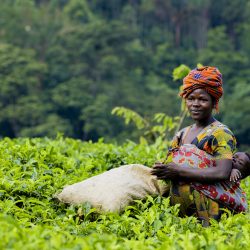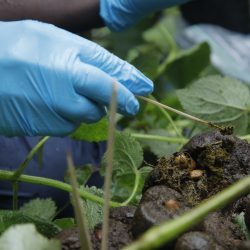Trekking at the Intersection of Climate Change and Gorilla Conservation
Blog | 10/02/10
The sense of stillness, clarity and peace are overwhelming as we approach the Gikeri patrol post. Fat fields of beans, cabbage and sweet potatoes stretch out in all directions, invoking a green carpet of bounty that seems to unroll all the way to the horizon. Earthen huts stand stoic with waving kids under waxy Eucalyptus leaves rustling in the breeze. As we approach the forest, it is still smothered with low slung clouds. But the sun is jostling to make an appearance as well, and we are lucky. No rain. At least not yet. It’s a long trek up the volcano, and it’s always much easier to do it in loose dirt and sporadic sun than torrents of rain and gulleys of sticky mud.
I have returned to Mikeno Volcano in Virunga National Park in the Democratic Republic of Congo today to walk another section of the transect: a line IGCP has cut in the forest on the volcano to study the impacts of climate change on gorilla habitat and the foods gorillas consume. IGCP’s point person on conservation science, Dr. Augustin Basabose, has come along with me and the rangers to investigate this middle section of the seven kilometer long transect. Dr. Basabose’s ambitious project will collect plant and tree data over a period of several years to help answer the question, “Is there a climate change impact on gorilla food distribution?” The results will help IGCP and its partners form a more informed and robust response to current and future mountain gorilla conservation efforts.
But first, we have to get to the transect, and Mikeno’s riot of weeds, vines, trees and overgrown everything won’t make it easy. We are relieved after a ranger confirms the trek to the transect is only thirty minutes and not three hours, which is what we were originally told after arriving at the lonely looking patrol post. As we set out, Augustin informs me the ranger teams collect data two times a month, and three teams do roughly two kilometers each of the transect. I feel sorry for the team that does the upper third: at around 3,000 metres (9,842 feet) the air is thin, the chill permanent, and the slope can often and abruptly turn almost vertical. Tackling this mid-section today is enough. We will start behind a bump on the jagged Volcano’s slopes called Mashahi Hill.
As we reach the transect the first tagged tree we stumble towards is number A641, a Neo Butonia. It’s crooked and ragged looking, like a lot of the trees in this difficult environment, but nevertheless looks perfect for rooting in this ragtag forest, and I wish I had taken more botany classes at university.
Up we climb, plunging into a tangled liana (vine) forest at 2,376 metres (7,800 feet). It is dense, and its permanent shade reveals a dark undergrowth with still bursting morning dew that sparkles like delicate jewels polished to perfection. The forest here is handsome in its almost mathematical precision: vines crisscross each other to produce an organic matrix of endless discoveries. Occasionally, they don’t the follow matrix principles, and bend elegantly around the backs of the thin shafts of trees struggling to break out of the dense web. I pick up what looks like tiny dried brown roses, a branch of wafer thin leaves grown in concentric circles. “Dombeya,” Augustin concludes. “It is very common here”.
As we pull ourselves up another hill so steep I could swear it is laughing at us, Augustin mentions that a fresh gorilla nest was spotted by a researcher not too far from here. The gorillas have stuck to the upper slopes of this section of Mikeno for awhile now. During the recent conflict, the forest from the road that runs alongside the Park up to here was devastated by human incursions. Villagers often camped here to escape the fighting, with rebel militias also a frequent presence to exploit the natural resources and take cover from other militias and the Congolese Army. With peace holding for over a year now, the hope is that the gorillas will populate this sector again, bringing other species with them. They surely will have enough food: we spy plenty of their favorites, such as nettles and wild celery.
My ears begin to pop as we climb higher, the dense understory of the forest opening up to reveal rolling wave after wave of crisp green stems and leaves. We spot the first Hagenia, a tall tree with branches like umbrella spindles that sprout small elongated oval leaves. Here the moss appears, hanging delicately from the branches in crumbly strands of pale light green. We don’t find any gorilla nests, but a rustling in the canopy interrupts the now constant thunder rumbling overhead, and I see a lone Golden Monkey skip across a long tree limb, with its illuminated brown body and mop-like head of hair. “The Hagenia is coming down to a really low elevation here,” says Augustin regarding this high mountain species, and with that, the skies open up.
The trek back down is more akin to downhill skiing on the rivers of mud that have now replaced the narrow dirt path, but by the time we make it down to the patrol post, the sun and smiling kids have come out again. It is always humbling to walk in the shadow of the gorillas, and breathe in the unparalleled beauty of the Virunga Volcanoes. It would be a tragedy from which our species would likely never recover if our own footprint on this earth destroyed this experience.
IGCP is not hesitating to take action, combining the integrity of science-based research and the fierce dedication of conservation professionals to counter any negative impacts of climate change on both human and gorilla communities in this small slice of luminous nature. We don’t yet know what we will find, and countering any negative impacts will be a difficult challenge that will take time and even fiercer dedication. But I know this organization is up for it, and I hope to come back in five, ten or twenty years time to walk again in the shadow of even more gorillas and wonder at the beauty of even thicker Hagenia forests. If, of course, these bad knees of mine can still tackle vertical Virunga….







